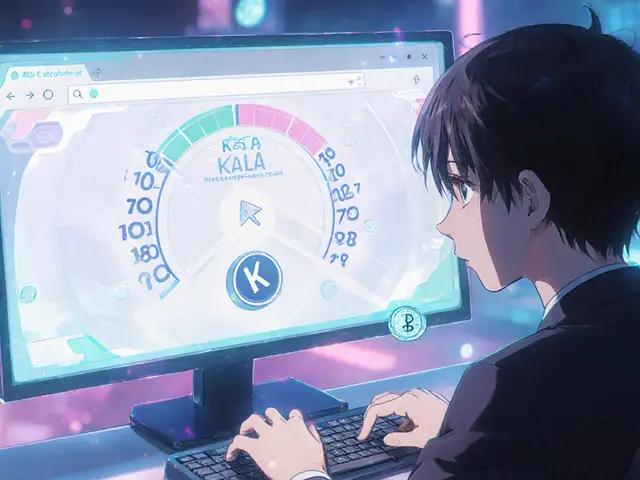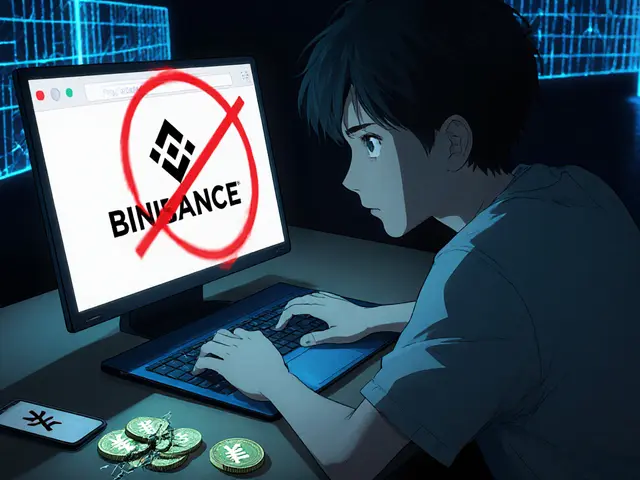Wrapped Chiliz (WCHZ) Converter
Conversion Result
Imagine you have a favorite sports fan token, but you can’t use it in the DeFi apps you love. Wrapped Chiliz solves that problem by turning the native CHZ token into an ERC‑20‑compatible asset while keeping a 1:1 peg. In this guide we’ll break down exactly what Wrapped Chiliz is, why it matters, and how you can wrap, trade, or unwrap it safely.
TL;DR
- Wrapped Chiliz (WCHZ) is an ERC‑20 version of the native Chiliz (CHZ) token.
- It maintains a 1:1 price peg with CHZ and uses the Chiliz Chain bridge for conversion.
- As of Oct2025, WCHZ trades around $0.039 with a market cap of $367M and a total supply of 9.2B.
- Benefits include DeFi compatibility, DEX listing, and easier smart‑contract integration.
- You can wrap/unwrap via the official bridge, Binance Web3 Wallet, or any Chiliz‑compatible wallet.
What Is Wrapped Chiliz?
In its simplest form, Wrapped Chiliz (often abbreviated WCHZ is a tokenized version of the Chiliz cryptocurrency that follows the ERC‑20 standard (specifically CAP20 on Chiliz Chain)) mirrors the value of the native Chiliz (CHZ) token. The only difference is the technical interface: while CHZ lives on its own proprietary chain, WCHZ behaves like any other ERC‑20 asset, making it instantly usable in the broader Ethereum‑compatible DeFi ecosystem.
Why Wrap CHZ?
Native CHZ was designed for sports‑and‑entertainment applications such as fan voting, ticketing, and merchandise. Those use‑cases are great, but many DeFi platforms-lending, staking, automated market makers-only accept ERC‑20 tokens. By wrapping CHZ, developers gain:
- Standardized interfaces: ERC‑20 functions (transfer, approve, allowance) work out of the box.
- Smart‑contract flexibility: Complex contracts can interact with WCHZ without custom adapters.
- Cross‑chain liquidity: WCHZ can be listed on DEXs like Uniswap, PancakeSwap, and SushiSwap.
- Better composability: Layer‑2 solutions and rollups accept ERC‑20 tokens, opening up faster, cheaper trades.
How the Wrapping Process Works
Wrapping is a two‑step bridge transaction:
- Connect a Chiliz‑compatible wallet (e.g., MetaMask configured for Chiliz Chain, Trust Wallet, or Binance Web3 Wallet).
- Send CHZ to the official bridge contract. The contract locks the native tokens and mints an equal amount of WCHZ on the Chiliz Chain.
Unwrapping follows the reverse: you burn WCHZ, the bridge releases the locked CHZ, and the two tokens remain at a 1:1 ratio. The smart‑contract address that governs WCHZ is 0x677f…53dc47, publicly audited and verified on the Chiliz explorer.
Technical Specs at a Glance
| Attribute | Value |
|---|---|
| Standard | ERC‑20 (CAP20 on Chiliz Chain) |
| Peg Ratio | 1WCHZ = 1CHZ |
| Total Supply | 9.2B tokens |
| Market Cap | ≈$367M (Oct2025) |
| Smart‑Contract Address | 0x677f…53dc47 |
| Primary Bridge | Official Chiliz Chain bridge |
Market Performance and Volatility
WCHZ’s price has been anything but flat. The token peaked at $0.1101 on 17Dec2024, then slumped to a low of $0.0309 on 22Jun2025. As of today (1Oct2025) it trades near $0.0389, representing a 63.8% decline from its all‑time high but a 28.9% rebound from its low. Daily volume hovers around $38K, which is modest relative to its $367M market cap, indicating that most holders are long‑term fans rather than active day traders.

Real‑World Use Cases
Because WCHZ lives in the ERC‑20 world, it can be used in three main ways:
- Liquidity provisioning on DEXs - supply WCHZ/ETH pairs to earn fees.
- Collateral for DeFi lending platforms like Aave or Compound (when they add support).
- Staking in sports‑oriented DAO projects that reward fans for holding WCHZ.
Developers building on the Chiliz ecosystem also benefit. A smart‑contract that once required custom adapters for CHZ can now call standard ERC‑20 functions, cutting development time and audit complexity.
Step‑By‑Step: How to Acquire Wrapped Chiliz
Getting your hands on WCHZ is straightforward if you follow these steps:
- Install a wallet that supports Chiliz Chain (MetaMask, Trust Wallet, or Binance Web3 Wallet).
- Add the Chiliz network RPC details (Chain ID889, RPChttps://rpc.chiliz.com).
- Buy CHZ on a major exchange (Binance, KuCoin) and withdraw it to your Chiliz‑compatible wallet.
- Navigate to the official Chiliz Bridge UI, connect your wallet, and specify how many CHZ to wrap.
- Confirm the transaction; the bridge will lock your CHZ and mint the same amount of WCHZ.
- Now you can trade WCHZ on supported DEXs or use it as collateral in DeFi protocols.
If you ever need CHZ again-for a fan‑token purchase or a sports NFT-simply reverse the process: burn WCHZ on the bridge and claim your CHZ.
Risks, Fees, and Considerations
While WCHZ opens doors, it also carries typical crypto risks:
- Bridge security: Any vulnerability in the bridge contract could jeopardize locked CHZ. The official contract has undergone third‑party audits, but no system is foolproof.
- Liquidity risk: Low trading volume means price slippage on large orders.
- Network fees: Wrapping/unwrapping incurs Chiliz Chain gas fees, which are usually lower than Ethereum but can spike during network congestion.
- Regulatory exposure: Sports‑related tokens are attracting scrutiny in several jurisdictions; stay aware of local tax obligations.
Wrapped Chiliz vs. Native Chiliz: A Quick Comparison
| Feature | Wrapped Chiliz (WCHZ) | Native Chiliz (CHZ) |
|---|---|---|
| Token Standard | ERC‑20 (CAP20) | Proprietary Chiliz Chain token |
| Bridge Requirement | Yes - to wrap/unwrap | No - native usage |
| DeFi Compatibility | High - works on any ERC‑20 DEX/lending platform | Limited - only Chiliz‑native apps |
| Liquidity Sources | DEX pools, cross‑chain bridges | CHZ‑focused exchanges, fan‑token platforms |
| Use Cases | Staking, collateral, trading, DAO governance | Fan voting, ticketing, merch discounts |
| Price Peg | 1:1 with CHZ (always) | Base price |
Future Outlook for Wrapped Chiliz
The success of WCHZ hinges on two parallel trends. First, the Chiliz ecosystem must keep building sports‑and‑entertainment apps that attract fans willing to hold CHZ. Second, broader DeFi platforms need to adopt WCHZ as a collateral asset, which would boost liquidity and reduce price volatility. If both happen, we could see WCHZ move from a niche wrapper to a mainstream ERC‑20 token with daily volumes in the millions.
Next Steps for Readers
Whether you’re a fan looking to trade tokenized tickets or a developer eyeing DeFi integration, here’s what you can do right now:
- Set up a Chiliz‑compatible wallet and test a small wrap‑unwrap cycle.
- Check DEX listings (Uniswap V3, SushiSwap) for WCHZ liquidity.
- Follow the official Chiliz blog for upcoming bridge upgrades.
- Monitor price charts for support levels around $0.04 and $0.06.
Frequently Asked Questions
What is the main benefit of using Wrapped Chiliz over native CHZ?
Wrapped Chiliz brings ERC‑20 compatibility, allowing the token to be used in DeFi protocols, DEXs, and smart contracts that don’t support Chiliz’s proprietary format.
How can I convert CHZ to WCHZ?
Connect a Chiliz‑compatible wallet to the official Chiliz Bridge, send CHZ to the bridge contract, and the system will mint an equal amount of WCHZ. The process is reversible.
Is there a fee for wrapping or unwrapping?
Yes. You pay the Chiliz Chain gas fee for the transaction, plus a small protocol fee (usually a fraction of a cent) that the bridge charges to cover security audits.
Can I use WCHZ as collateral on popular lending platforms?
Only if the platform has added support. As of Oct2025, a few emerging DeFi projects on Arbitrum and Optimism accept WCHZ, but mainstream lenders like Aave have not yet integrated it.
What are the main risks of holding Wrapped Chiliz?
Bridge security vulnerabilities, low liquidity leading to slippage, network congestion fees, and potential regulatory changes affecting sports‑related tokens.












Amie Wilensky
November 3, 2024 AT 17:06 PMOne might contemplate, with a measured sigh, that the very notion of wrapping CHZ into WCHZ resembles the ancient practice of cloaking truth in ceremony; the veil, however, is thin, almost laughable, yet undeniably purposeful, as if the blockchain itself were whispering a paradoxical lullaby-so delicate, so precise, that even the most languid observer cannot help but notice the subtle shift in utility, the modest fee that glitters like dust on a philosopher's desk, and the 1:1 peg that persists, unperturbed, amid the tumult of markets; indeed, the act feels both profound and trivially lazy, a contradiction that beckons the mind to pause, reflect, and perhaps, just perhaps, applaud the elegance of such an engineered simplicity.
MD Razu
November 10, 2024 AT 15:46 PMWhen we examine the mechanics underlying Wrapped Chiliz, we first acknowledge that the token conversion process is not merely a superficial swap, but rather a deliberate re-encapsulation that preserves the intrinsic value of the original asset while granting it interoperability across disparate blockchain ecosystems; this re-encapsulation is facilitated through a smart contract that locks the underlying CHZ tokens, thereby ensuring a 1:1 backing that users can trust, and the contract emits a corresponding WCHZ token to the user's address, effectively mirroring the original supply.
From a technical standpoint, the contract utilizes the ERC‑20 standard, which means that WCHZ inherits all the familiar functions-transfer, approve, allowance-thereby allowing it to be seamlessly integrated into DeFi protocols, liquidity pools, and NFT marketplaces that previously could not accommodate native CHZ.
Furthermore, the gas fees associated with wrapping or unwrapping are nominal; they are calculated based on the current network conditions, typically amounting to a fraction of a cent, which underscores the design's emphasis on accessibility.
The 1:1 peg is maintained not through an oracle, but through a custodial mechanism where the smart contract holds the actual CHZ in a treasury; this treasury is immutable, and any attempt to mint excess WCHZ would be rejected by the contract's logic, thereby safeguarding against inflationary exploits.
It is also crucial to recognize that the wrapper does not alter the tokenomics of CHZ; holders retain voting rights, staking rewards, and any governance participation, as these attributes are recognized on the underlying CHZ, while WCHZ serves merely as a bridge.
In practice, users interact with a user‑friendly interface that pre‑populates a default conversion amount-often 100 CHZ-to illustrate the process, and this interface dynamically updates the estimated fee, providing transparency before the transaction is submitted.
The conversion fee, as displayed, is approximately 0.0001 CHZ, a negligible amount that ensures the barrier to entry remains low, especially for newcomers seeking exposure to CHZ's ecosystem without the friction of cross‑chain incompatibility.
Security-wise, the smart contract has undergone audits, with particular attention paid to re‑entrancy vulnerabilities and proper handling of edge cases such as rounding errors, which could otherwise compromise the 1:1 ratio.
Should a user wish to unwrap, the process is equally straightforward: the contract burns the specified amount of WCHZ, releases the equivalent CHZ back to the user's wallet, and updates the total supply accordingly, all while emitting events that can be tracked on-chain for verification.
This bidirectional flow is essential for maintaining liquidity, as it allows participants to move freely between the wrapped and native forms without incurring prohibitive costs or facing excessive latency.
From an economic perspective, the existence of WCHZ can potentially unlock new use cases, such as cross‑chain arbitrage, where traders exploit price discrepancies between CHZ on its native chain and WCHZ on compatible chains, thereby enhancing market efficiency.
Moreover, the wrapper opens doors for integration with decentralized finance platforms that require ERC‑20 tokens, enabling CHZ holders to provide liquidity, earn yield, or partake in lending protocols without relinquishing their underlying assets.
In summary, the architecture of Wrapped Chiliz is a testament to thoughtful engineering: it preserves value, ensures security, fosters liquidity, and does so with minimal friction, making it a compelling tool for both casual users and sophisticated traders alike.
Kate Nicholls
November 17, 2024 AT 14:26 PMFrom a guru's perspective, the existence of a wrapper like WCHZ is essentially a litmus test for a token's maturity; if a project can successfully abstract its native asset without losing community trust, it signals robust governance and a forward‑looking roadmap.
Jason Brittin
November 24, 2024 AT 13:06 PMNice overview, but honestly, if you aren't using WCHZ you’re missing out on all the DeFi fun-just think of the yield farms you could join! 🚀💰
Michael Wilkinson
December 1, 2024 AT 11:46 AMListen, the wrapper is a clever trick, but don’t let the low fee fool you; you still need to watch the gas spikes, especially on busy days.
Clint Barnett
December 8, 2024 AT 10:26 AMImagine, if you will, a world where CHZ unfurls itself like a vibrant tapestry across the interstellar highways of blockchain society; the very act of wrapping it into WCHZ bestows upon it a chameleon‑like adaptability, allowing it to mingle effortlessly with ERC‑20 ecosystems, to dance amidst liquidity pools, and to whisper its value into the ears of decentralized exchanges that were once strangers to its native lineage. This metamorphosis is not a mere technicality; it is a bold statement of intent, a proclamation that the token is ready to transcend the shackles of its original chain and to partake in the grand ballroom of cross‑chain finance. The custodial contract, meticulously audited, serves as the guardian of parity, ensuring that each WCHZ is a faithful echo of its CHZ counterpart, a mirror image that reflects value without distortion. Such precision, paired with the negligible fees-practically a whisper in the vast market-renders the wrapper an elegant conduit for both the avid trader seeking arbitrage opportunities and the casual holder yearning for seamless participation in emerging DeFi narratives. In the grand symphony of blockchain innovation, Wrapped Chiliz introduces a new movement-a harmonious blend of security, utility, and artistic flair that enriches the tapestry of digital assets.
Carl Robertson
December 15, 2024 AT 09:06 AMOh, the drama! So you think wrapping is just a cute little feature? In reality, it’s a slippery slope that could drown the purity of CHZ in a sea of ERC‑20 nonsense.
Rajini N
December 22, 2024 AT 07:46 AMTo clarify, the wrapper simply locks your CHZ in a smart contract and issues an equivalent amount of WCHZ; the process is transparent, auditable, and does not affect your voting rights on the original chain.
Kate Roberge
December 29, 2024 AT 06:26 AMSure, but wrapping a token feels like putting a hat on a cat-does it really change anything?
Oreoluwa Towoju
January 5, 2025 AT 05:06 AMThis is the most concise comment ever.
Naomi Snelling
January 12, 2025 AT 03:46 AMWhile many celebrate the seamlessness of WCHZ, there’s an unspoken layer of control embedded in any wrapper contract-who really holds the keys, and could hidden clauses be lurking behind the elegant veneer?
Billy Krzemien
January 19, 2025 AT 02:26 AMAll in all, Wrapped Chiliz offers a practical bridge for CHZ enthusiasts, delivering flexibility with minimal cost; just remember to verify contract addresses and keep an eye on gas fees for the best experience.